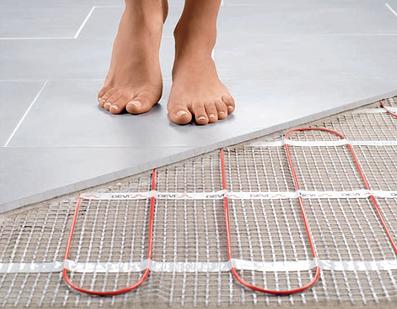Underfloor heating with electric cables
No maintenance – only a timer and /or thermostat to control the usage of electricity. It can be used in conduction with other ways of heating to give a comfortable surface temperature of the floor-surface. Night-tariff could be used to minimize the costs per used kWh. The installation costs in a new house are lower than for any other system. The drawback is of course the dependency on electricity. This could be justified in a small and highly insulated house where the amounts of electricity used would be very small. Another bonus is that floor-heat cables embedded in the concrete raft can quickly dry out the concrete in a new house.
In practice it is only the very weak (approx. 200W) cables in each wet-room (bath and utility) that are used in most of our newer houses. It is used primarily to give super- luxurious warm bathrooms floors. The longer cable that stretches under the rest of the house is rarely or never used – no need in a passive house.
Together with PV-panels on the roof it is a great way to use up surplus electric energy generated on the roof. A problem is naturally that a passive house needs no space-heat at all for 8-9 months of the year in the mild Irish climate.


Heat rises
This simple fact explains why DEVI floor-heatcables provides more comfortable warmth than alternative radiator systems. A radiator system throws heat up at head height which then travels further up to the ceiling only to travel downwards and return as a cold draft around one’s feet. DEVI underfloor heating on the contrary, provides appropriately pleasant warmth for your feet, body and head. As it produces only very gentle air circulation, the amount of travelling dust particles is reduced considerably which naturally is a great relief for people with allergies or asthma.
Under all sorts of floors
DEVI floor-heating system can be used anywhere in the house, regardless whether the floor is constructed with floorboards on joists or wood-laminates or massive parquet on concrete supported by joists. Under all circumstances it is important that the floor is well insulated below to ensure the best heating comfort and most economical result. In low-energy houses the installed heating effect is usually lower than 50w/m2. This low effect eliminates all problems with overheating.
Wood is a natural material which contracts or expands depending on the temperature. This puts demands on a floor heating system to distribute the heat in a gentle and controlled way. Usually the wooden floor manufacturers prescribe a max. temperature of 27° which must not be exceeded.


Controls.
A simple thermostat with floor-sensor controlling each circle is normally used. A more advanced touch control with programmable timer and thermostat is on the option list. Example: Devireg™ 540/550 dual function thermostat. It controls the heating cables with a combination of temperature and the programmed timer.
- In passive houses the installed heating effect is lower than 10W/m2 (low energy houses max 50W/m²)
- This low effect eliminates all possible problems of overheating.
Elecro-magnetic fields and health aspects
Are there harmful electro-magnetic fields? All electrical equipment and installations have electro-magnetic fields (EMF). Measurements of EMF from floor-warming system show values far below the hygienic limit values established.
Is it healthy with a floor-warming system? Yes, the floor-warming systems are clean and healthy because the heat flows up from the floor instead of air being circulated in standard radiator system.
It is good for allergies and recommended by the Asthma Foundation in several countries.

Lifespan of conceiled cables
What is the lifetime? DEVI™ has been producing heating cables for around 40 years and there have been no cases, to the best of our knowledge, of a system malfunction due to aging.
The lab simulations suggest a lifetime of at least 50 years. Basically, we can say that the heating cables embedded in concrete will last at least as long as the normal hidden electrical wiring in a house.
| DEVI DTIP Technical Specifications | |
| Cable construction Rated voltage Watts per meter Diameter Conductor insulation Sheath Rated temperature Approval Pulling strength Deformation strength Warranty |
Twin conductor 230V 8, 10, 18 W/m 7.0 mm PEX PVC 90i 65iC IEC 800/Demko/CE 200 N 2000 N 10 years |
